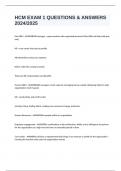HCM EXAM 1 QUESTIONS & ANSWERS
2024/2025
Past HRM - ANSWERSHR manager = paper pushers who organized personnel files (little old lady with gray
hair)
HR = cost center that eats up profits
Administrative and just an expense
Didn't make the company money
They just did compensation and benefits
Present HRM - ANSWERSHR managers create value by managing human capital; deploying talent to help
organization meet its goals
HR = productivity and profit center
training, hiring, finding talent, making sure everyone is happy, motivates
Human Resources - ANSWERSthe people within an organization
Employee engagement - ANSWERSa combination of job satisfaction, ability, and a willingness to perform
for the organization at a high level and over an extended period of time
Cost center - ANSWERSa division or department that brings in no revenue or profit for the organization -
running this function only costs the organization money
,productivity center - ANSWERSrevenue center that enhances profitability of the organization through
enhancing the productivity of the people within the organization
Productivity - ANSWERSthe amount of output that an organization gets per unit of input, with human
input usually expressed in terms of units of time
effectiveness - ANSWERSa function of getting the job done whenever and however it must be done
Efficiency - ANSWERSa function of how many organizational resources we used in getting the job done
Knowledge workers - ANSWERSworkers who "use their head more than their hands" and who gather and
interpret information to improve a product or process for their organizations
turnover - ANSWERSthe permanent loss of workers from the organization
absenteeism - ANSWERSthe failure of an employee to report to the workplace as scheduled
sustainable competitive advantage - ANSWERSA capability that creates value for customers that rivals
can't copy quickly or easily, and allows the organization to differentiate its products or services from
competitor products
Technical skills - ANSWERSthe ability to use methods and techniques to perform a task
Interpersonal skills - ANSWERSthe ability to understand, communicate, and work well with individuals
and groups through developing effective relationships
Empathy - ANSWERSthe ability to put yourself in another person's place- to understand not only what
that person is saying but why the individual is communicating that information to you
Conceptual and design skills - ANSWERSthe ability to evaluate a situation, identify alternatives, select a
reasonable alternative, and make a decision to implement a solution to a problem
,Business skills - ANSWERSthe analytical and quantitative skills, including in-depth knowledge of how the
business works and its budgeting and strategic planning process, that are necessary for a manager to
understand and contribute to the profitability of their organization
HR Managers' Challenges: Control - ANSWERSNo direct control over people
- Productivity:background check, flexible work days, career opportunities
- Job satisfaction: work space, fair compensation, time off, letting them chose and have a say
(independent)
- Turnover: when people leave an organization it is very expensive: takes 6 months to learn and make the
company money
- Absenteeism: people not showing up for work (time off without pay but not vacation), sick time (hurts
productivity), burnout day, PTO bad (Paid time off --> carries over, sick, vacation, can be used for
anything)
Therefore they must create workplace conditions that foster employee willingness and desire to come to
work and perform effectively and efficiently
- Benefits that keep people with us: cafeterias, pet insurance, time off, company car
HR Strategy - ANSWERSShift from reactive to proactive
Creating competitive advantage
- What company does well, that is not easily duplicated by others, and helps us to make money
- Reaching goals set in strategic plans
- Sitting at the table --> needs to be included with vice president of marketing, finance supply chain, etc.
(Google: People in strategy)
The Main Goals of Strategic HRM - ANSWERSEncourage employees through motivation, leadership,
environmental analysis and organizational changes that work to improve job satisfaction
Employee engagement --> increases productivity --> job satisfaction --> lowers absenteeism and turnover
Recurring from different industry, organizational changes, working remotely, structure
, Technology and Knowledge in HRM - ANSWERSChange from administrator to strategic partner
- Less "labor intensive" more technology intensive (for things like benefits and compensation)
- Knowledge work (research)
--> understanding the best way to interview (virtual or face-to-face), see communication skills, see eye
contact, see how you work under pressure
Talent Pool and Demographic Challenges for HR managers - ANSWERSIncreased competition to hire and
retain talent with right skills, at the right time, and in the right place
- Basic HR equation
Cultural flexibility required for changing workplace demographics
- Generational differences: all different people bring different personalities to work
- Affinity groups: groups of people that have similar characteristics --> Penn State group women in
business --> not their social lives, company wants employees to feel connected to community and
company (about retention)
- Work styles: all different people born different personalities into the workplace --> talking on the phone
or texting
- Abilities verse disabilities: more people now in the workforce with disabilities
- Just to name a few!
Focusing on what employees can bring to the work force, not what they can do
SHRM Competency Model - ANSWERSCOMPETENCY: what you can do with a skill
Relationship management: team, customers, maintaining relationships, business partners
Ethical practice: be confidential, have a lot of info about people's lives
HR expertise: specialize in compensation, training, benefits, etc.




